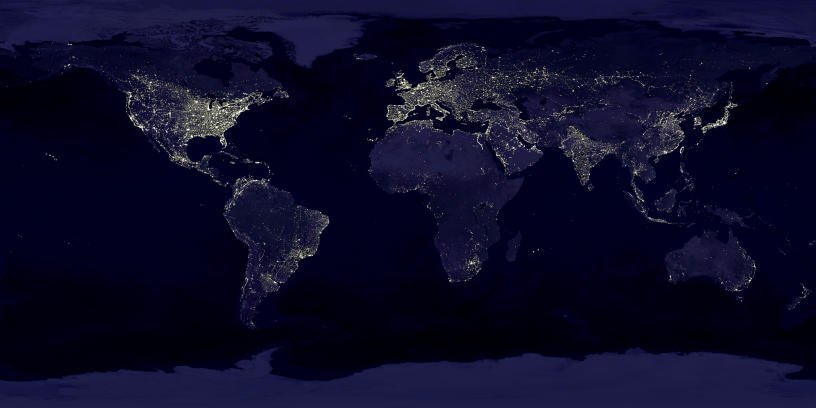
satellite image of lights at night
Source: Defense Meteorological Satellite Program, Global City Lights

satellite image of lights at night
Source: Defense Meteorological Satellite Program, Global City Lights
As the population of Virginia increases, artificial illumination at night expands and spoils the view of the stars and planets.
In many cases, mercury vapor security lights are placed on a pole near the house in isolated valleys. In urban settings, lights on streets, in shopping centers, and across developments create an environment in which children are never exposed to the constellations. Only during major power failures (blackouts) do residents in urbanized areas get to see the Big Dipper or Orion. According to the National Park Service:1
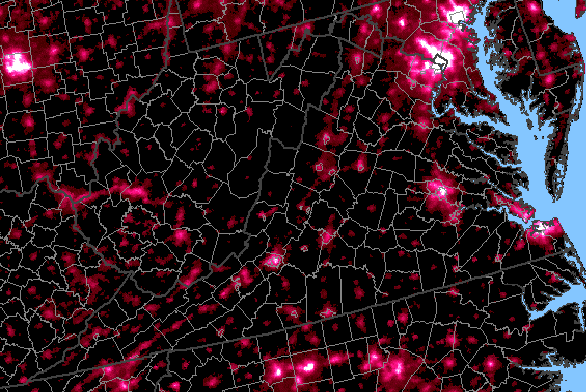
night lights of Virginia, showing concentrations of human settlement
Source: National Atlas
Star visibility can be measured by identifying the magnitude of the faintest stars that are visible. People with excellent visual acuity might spot 8.0 magnitude stars, without a telescope, in a place with no artificial light intrusion. In an urban setting, stars with a magnitude beyond 4.0 are rarely visible.
The Bortle Dark-Sky Scale provides nine categories based on the overall brightness of the sky and the visibility of objects such as nebulae and galaxies. Under the best Class 1 conditions ("observer's Nirvana!"), the galaxy M33 is an obvious naked-eye object. In a Class 9 inner-city sky, no Messier objects are visible to the unaided eye except perhaps the Pleiades.2
The International Dark Sky Federation defines "inappropriate or excessive use of artificial light" as light pollution, a form of waste. The four components are:3
The World Atlas of Artificial Night Sky Brightness estimates skyglow pollutes the night sky for 80% of the world's population, and 99% of people in the United States and Europe live under night skies damaged by light pollution.
Much of the light pollution began in the 1950's, when streetlights were added on an expanding highway network and stores began staying open later at night. Today, the stores that at one time were open between just 7:00am to 11:00pm, such as 7-11, are now open 24 hours a day.
Streetlights were adopted as a safety measure after a 1971 study concluded that illumination could reduce nighttime crashes by 40%. Today, 50% of an average city's costs for energy use is due to street lights.
More-efficient streetlights using LED (light-emitting diodes) can reduce electricity use and greenhouse gas emissions, but make the light pollution problem worse. LED's produce light in shorter (blue) wavelengths that can travel further.
The health impacts can be significant as well. According to the American Medical Association, exposure to the light emitted at night by LED's alter the natural cycle of light and dark and reset the circadian pacemaker. The higher intensity of light in the shorter blue wavelengths suppresses the natural cycle for release of melatonin, creating potential carcinogenic effects - especially breast cancer. Fundamentally, the:4
Shenandoah National Park started an annual Dark Sky Festival in 2016, to interpret a natural resource about which many visitors were unfamiliar. The National Park Service later partnered with the Illuminating Engineering Society (IES) to develop lighting standards and best practices so future construction projects in units of the National Park System would be "night sky friendly."5
Sky Meadows State Park has recognized that it has a natural asset valued by Northern Virginians - a dark sky where stars are visible. The state park sponsors special astronomy programs, and offers a perspective on the natural world just as valuable as hikes along the Appalachian Trail. It is one of five Virginia parks have gained recognition as an International Dark Sky Park:6
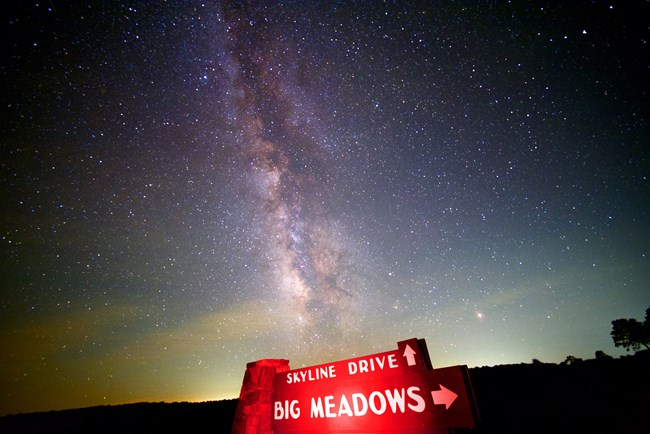
Shenandoah National Park offers an annual Night Sky Festival
Source: NASA, Night Sky
To achieve designation, Natural Bridge State Park realigned the lights that were pointed upward to illuminate the bridge all night. The Rockbridge County Board of Supervisors and the Lexington City Council both supported the designation, and indicated they would prevent new light pollution near the park so it can retain the designation. The sky at Natural Bridge is not completely dark; visitors can see the "skyglow" of Glasgow, Lynchburg, and Roanoke close to the horizon.
Some communities away from state parks, such as Charlottesville, also are implementing "dark sky" ordinances that require shields on lights so the illumination is directed towards the ground.7
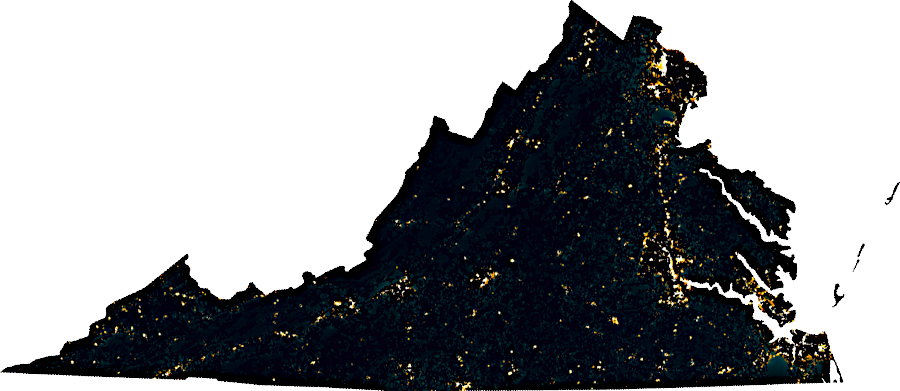
amount of light emitted per person in Virginia
Source: Tim Wallace, Descartes Labs, National Atlas (using nighttime data from the National Oceanic and Atmospheric Administration)
Even in urbanized Fairfax County, there was an opportunity to create a dark sky park. In October 2021, the Fairfax County Park Authority nominated Observatory Park at Turner Farm in Great Falls for "dark sky" designation by the International Dark Sky Association. County officials spent several years seeking consensus among local residents before amending zoning standards for outdoor lighting within a half-mile of the observatory.
Opponents, including members of the Foxvale Farm's homeowners' association, questioned the impact on crime if outdoor lighting was constrained and the benefits of proposed limits. They noted the expanding light pollution from new development at Tysons was not being reduced. The telescope at nearby Thomas Jefferson High School for Science and Technology was no longer being used due to light pollution.
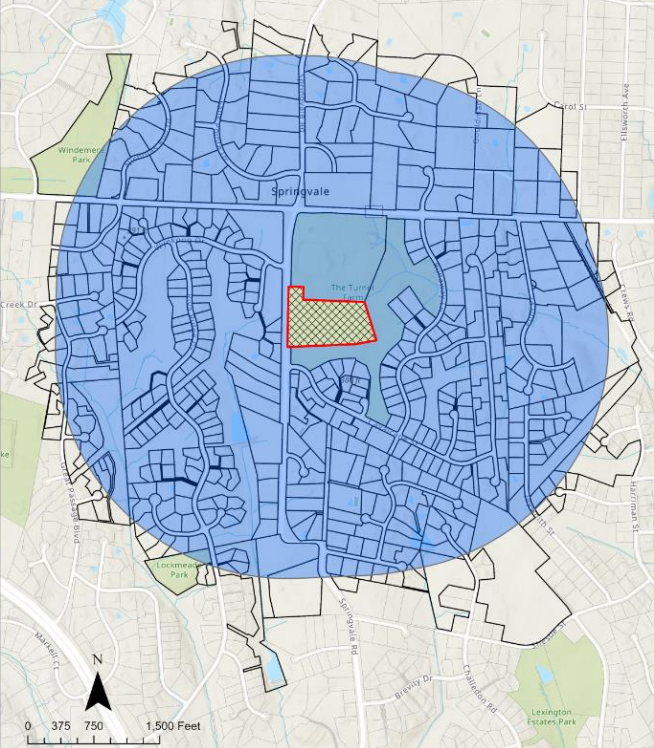
525 lots were within 1/2 mile of Observatory Park at Turner Farm
Source: Fairfax County Planning and Development, Staff Report: Outdoor Lighting Around Turner Farm Park Observatory (Figure 2)
The Fairfax County Planning Commission finally moved forward in October 2023 even though a community consensus was not reached. The Planning Commission recommended that the Fairfax Board of County Supervisors set limits on the number of "up lights" or spotlights allowed, and restrict new outdoor light fixtures to 300 lumens.
On November 21, 2023, the Fairfax Board of Supervisors approved final regulations to preserve dark skies within a half-mile of the Turner Park Farm Observatory in Great Falls. Outdoor up-lights or spotlights were restricted to 300 lumens, while motion-activated outdoor lights were limited to 1,500 lumens (about a 100-watt incandescent bulb). All new outdoor lights, except those at a door or a garage emitting no more than 1,500 lumens, had to be fully "cut-off," meaning all light was directed downwards and no light was directed horizontally.8
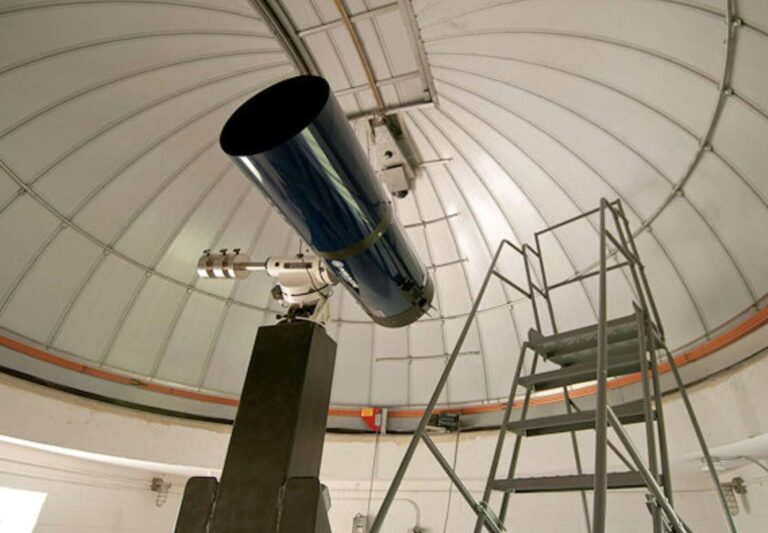
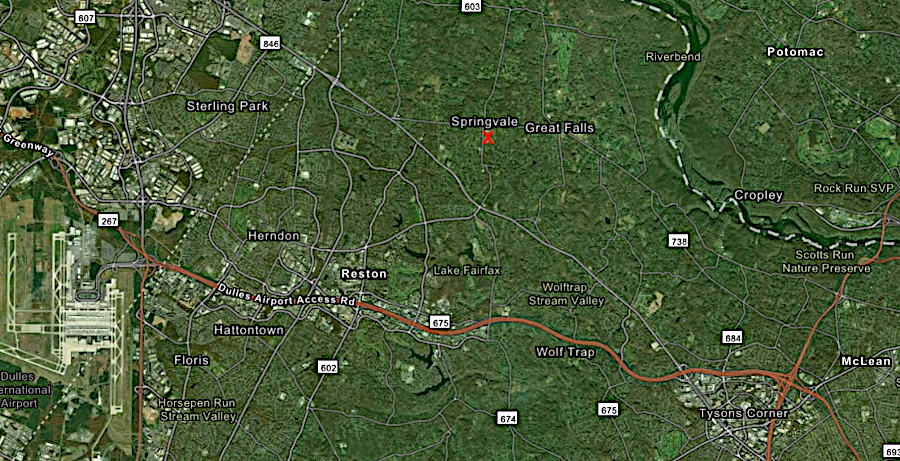
Fairfax County Park Authority sought dark sky designation in 2021 for Observatory Park (red X), about six miles northwest from Tysons and seven miles from Dulles
Source: Fairfax County, The Turner Farm and ESRI, ArcGIS Online
At the same meeting, the supervisors also authorized brighter electronic signs in commercial and industrial zoning districts, as new screens using LED lights were able to shine more brightly. "Brightness" was measured in units called "nits," a measurement of luminance. Typical computer monitors, TVs, and cellphones range from 250-600 nits. Outdoor signs require a highter level of brightness.
The Fairfax County Board of Supervisors increased the authorized level for outdoor signs from 100-300 nits. A representative of Dark Sky Friends described the decision as:9
In 2025, Front Royal began replacing its 2,000 municipal lights with shielded light fixtures that were DarkSky-compliant. The new LED bulbs had a "warm white" color temperature of 3000 Kelvin. The bulbs also had a longer life expectancy of 50,000-100,000 hours, compared to the 6,000-15,000 hour lifespan of bulbs being replaced.10

lights of Norfolk (southeast corner), Richmond, and Northern Virginia reveal the crescent of dense population in Virginia (Lynchburg is circled in red, Charlottesville in yellow)
Source: NASA, Earth's City Lights
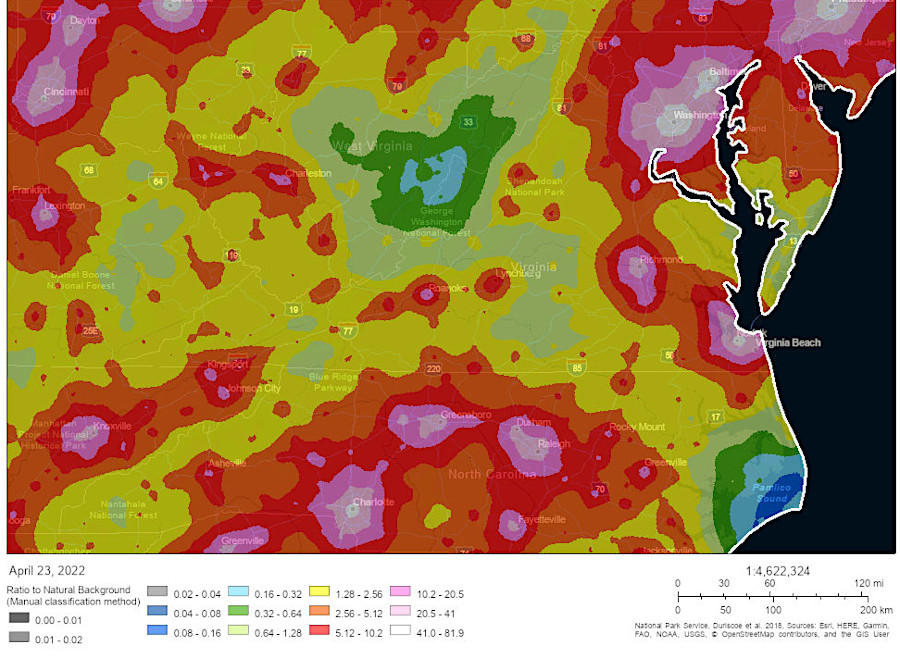
light pollution is concentrated in urban areas, but extends across the entire state
Source: National Park Service and National Aeronautics and Space Administration, Risk Map: Mapping Anthropogenic Night Light and Noise
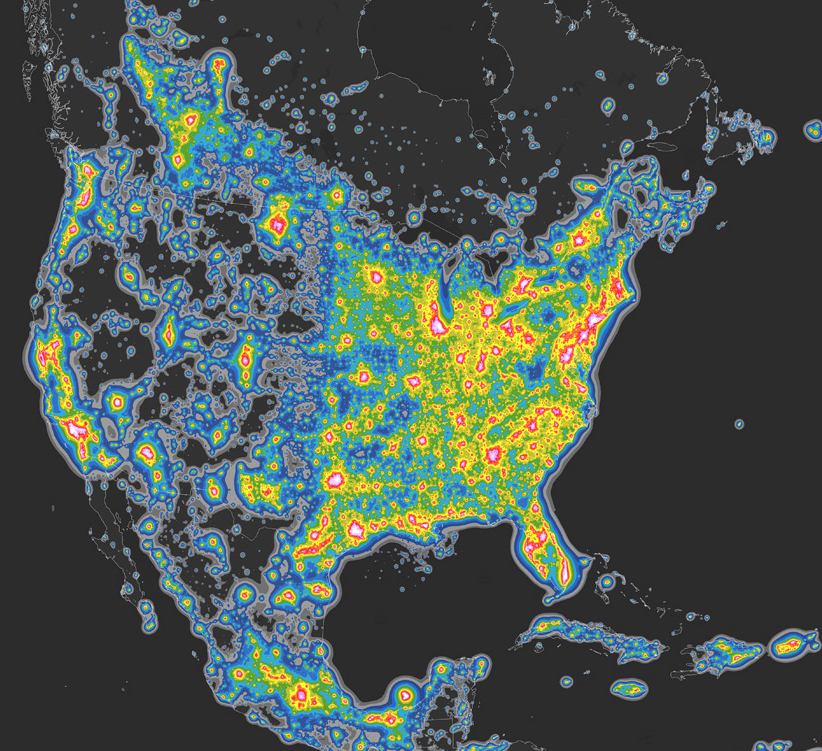
light pollution is one of the most pervasive forms of environmental alteration
Source: Fabio Falchi et al., Science Advances, The new world atlas of artificial night sky brightness (June 10, 2016)